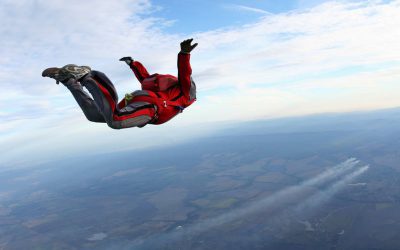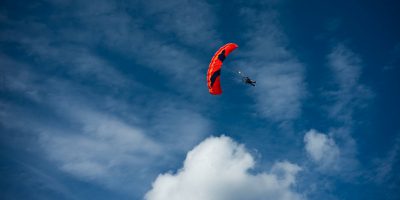As a sport that transpires in the “wild blue yonder,” skydiving is entirely weather dependent. Usually, the reasons for a weather delay are conditions that are visually apparent. With one glance up, it’s pretty easy to see if there is a torrential downpour or an overcast sky swirling with low, gray clouds. Naturally, when you arrive at the dropzone and are greeted by a brilliant blue sky, you expect to be able to skydive. However, even on a lovely, clear-sky day, there is another equally important weather condition that must be assessed before any skydiving takes place. This condition is wind speed.

What is the tandem skydiving wind limit?
Because different regions are susceptible to different average wind speeds, there is no published tandem skydiving wind limit. Rather, the decision to skydive or not is left to the tandem instructor and the dropzone. To make the decision on whether or not it is a safe skydiving wind speed the instructor and dropzone will take a few things into consideration.
Wind Conditions That Affect Tandem Skydiving
Turbulence
What may seem like just a breeze could become far more sinister when it comes time to land the parachute. As wind travels over the surface of the earth, it encounters obstacles. At the drop zone these obstacles are things like trees and buildings. As the wind travels over these obstacles, it creates vortices behind them. These “swirling” winds (sometimes called “dirty air”) cause turbulence. Furthermore, wind vortices and “dirty air” can cover a span of area 10 to 20 times the height of the obstacle that the wind encountered.
The particularly pesky problem with turbulence is you cannot see it, but you can determine if it is present based on the wind direction. On any given day, the winds may come from a direction that could cause significant turbulence for landing parachutes. If this is the case, the dropzone and instructor may make the decision to stand down until the wind shifts, and it is safe to resume operations.
Gusts
Wind gusts are brief periods of time characterized by increased wind speeds. The “spread” in the speed of these gusts is particularly important. If the wind is coming from a good direction, a gust from 5kts-10kts may be completely manageable. However, if the gust is 0kts-14kts, it’s another matter entirely. In order to safely skydive, the wind speed must be somewhat steady. Gusts of wind can not only make for a bumpy ride, but significant gusts can drastically affect the flight performance of the parachute.
Winds At Exit and Opening Altitude
To determine whether the conditions for skydiving are safe, we must also consider the winds up at altitude. Occasionally, the winds from our exit altitude to our parachute deployment/opening altitude can be so severe that it is unsafe for us to skydive. Here’s why. Excessive wind speeds at our exit altitude can cause significant freefall drift taking us farther away from the landing area than we should be. High winds at the parachute opening altitude can potentially prevent the large tandem canopies from making it back to the landing area safely.

How is a tandem skydiving wind limit determined?
Dropzones use a variety of tools to determine if the wind conditions are safe for skydiving. One of the most commonly used tools is an anemometer. This handheld digital device measures the winds to provide a reading of the wind speed and wind gusts on the ground. Additional information for ground wind speed and direction is also gathered from the Automated Weather Observation System, which is an airport weather system that provides continuous real-time weather information. In order to determine the wind speeds up at altitude, dropzones often use a winds aloft report that is generated by the Federal Aviation Administration coupled with real-time readings from pilots.
By using a combination of wind readings on the ground, the information provided on the winds at altitude, and by taking into account both wind speed and direction, a tandem instructor and dropzone will determine whether the wind speed has exceeded a safe tandem skydiving wind limit.
Though wind delays can certainly be frustrating, it’s important to remember that we have your safety and the safety of instructors in mind. If you have any questions about tandem skydiving wind limits or would like more information on making your first jump, contact Skydive Monroe today!
Copyright © 2024, Skydive Monroe, All Rights Reserved.
DropZone Web Design & Marketing by Beyond Marketing, LLC



